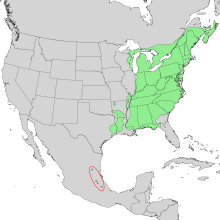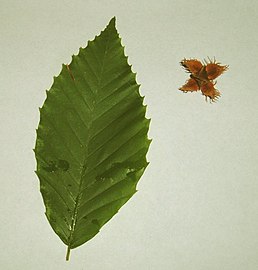Fagus grandifolia
| American beech | |
|---|---|

| |
| Scientific classification | |
| Kingdom: | Plantae |
| Clade: | Tracheophytes |
| Clade: | Angiosperms |
| Clade: | Eudicots |
| Clade: | Rosids |
| Order: | Fagales |
| Family: | Fagaceae |
| Genus: | Fagus |
| Species: | F. grandifolia
|
| Binomial name | |
| Fagus grandifolia | |
| Subspecies[3] | |
| |

| |
| It is naturally found from Eastern Canada to Central Mexico[3] | |
| Synonyms[3] | |
|
Fagus grandifolia var. typica Rehder | |
This article needs additional citations for verification. (April 2019) |
Fagus grandifolia, the American beech or North American beech, is the only species of
Description
Fagus grandifolia is a large
-
Beech and maple seedlings in Tennessee
-
Stump with carving
-
Bark with lichen
-
Spring leaves
-
Beech leaf and nut
-
Autumn foliage
-
The long and thin winter bud
-
Marcescent leaves in late winter
-
Beechnuts
Taxonomy
Trees in the southern half of the range are sometimes distinguished as a variety, F. grandifolia var. caroliniana, but this is not considered distinct in the Flora of North America. The Mexican beech (F. grandifolia subsp. mexicana), native to the mountains of central Mexico, is closely related, and is treated as a subspecies of American beech, but some botanists classify it as a distinct species. The only Fagus species found in the Western Hemisphere (assuming the Mexican subspecies is treated as such), F. grandifolia is believed to have spanned the width of the North American continent all the way to the Pacific coast before the last ice age.
Two subspecies are generally recognized:[3]
Etymology
The genus name
Distribution and habitat
The American beech is native to eastern North America, from Nova Scotia west to southern Ontario in southeastern Canada, west to Wisconsin and south to eastern Texas and northern Florida in the United States, as well as the states of Hidalgo, Veracruz, Tamaulipas, Puebla, San Luis Potosí, and Tabasco in Mexico.[10] Mature specimens are rare in lowland areas as early settlers quickly discovered that the presence of the tree indicated good farmland.
The American beech is a
Ecology
The mast (crop of nuts) from American beech provides food for numerous species of animals. Among vertebrates alone, these include various birds[7] including ruffed grouse and wild turkeys, raccoons,[7] foxes,[7] white-tailed deer,[7] rabbits, squirrels,[7] opossums, pheasants, black bears,[7] and porcupines.[7] Beech nuts were one of the primary foods of the now-extinct passenger pigeon;[7] the clearing of beech and oak forests is pointed to as one of the major factors that may have contributed to the bird's extinction.[13] Some Lepidoptera caterpillars feed on beeches. Deer occasionally browse on beech foliage,[7] but it is not a preferred food.
Diseases and pests
Beech bark disease has become a major killer of beech trees in the Northeastern United States. This disease occurs when the European beech scale insect, Cryptococcus fagisuga, attacks the bark, creating a wound that is then infected by Neonectria ditissima or Neonectria faginata, two species of fungi. This causes a canker to develop and the tree is eventually killed.[14]
Beech leaf disease is caused by the nematode Litylenchus crenatae mccannii. It was discovered in Ohio in 2012 and identified as far south as Virginia in 2022.[15] Beech leaf disease causes severe damage to the American beech and also to the related European beech.[16]
The beech leaf-miner weevil, a species native to Europe, has been identified in North America as a cause of defoliation of American beech trees.[17] American beech trees have small gaps and crevices at the base of their trunks in which the pest overwinter before eventually making their way to the buds of the trees and finally laying eggs on the underside of the leaves.[18] Once hatched, the larvae mine the leaves, causing destruction to the foliage.
Beech blight aphids colonize branches of the tree, but without serious harm to otherwise healthy trees. Below these colonies, deposits of sooty mold develop caused by the fungus Scorias spongiosa growing saprophytically on the honeydew the insects exude. This is also harmless to the trees.[19]
Despite their high moisture needs, beeches succumb to flooding easily and their thin bark invites damage from animals, fire, and human activities. Late spring frosts can cause complete defoliation of the tree, although they typically recover by using reserve pools of sugar.[20] The trunks of mature beeches often rot and develop cavities that are used by wildlife for habitation.[21]
Uses
American beech is an important tree in forestry.[citation needed] The wood is hard and difficult to cut or split, although at 43 pounds per cubic foot (0.69 g/cm3) it is not exceptionally heavy, and it also rots relatively easily.[citation needed] It is used for a wide variety of purposes, most notably bentwood furniture as beech wood easily bends when steamed.[citation needed] It also makes high quality, long-burning firewood.
Like European beech bark, the American beech bark is smooth and uniform, making it an attraction for people to carve names, dates, decorative symbols such as love hearts or gang identifiers, and other material into its surface.[22] One such beech tree in Louisville, Kentucky, in what is now the southern part of Iroquois Park, bore the legend "D. Boone kill a Bar 1803."[23] The beech finally fell over in 1916 during a storm; its age was estimated at around 325 years. Its trunk is now on display at the Filson Historical Society.
It is sometimes planted as an ornamental tree, but even within its native area, it is planted much less often than the European beech. Although American beech can handle hotter climates,[24] its European cousin is faster-growing and more pollution-tolerant, in addition to being easier to propagate.[citation needed]
American beech does not produce significant quantities of nuts until the tree is about 40 years old. Large crops are produced by 60 years. The oldest documented tree is 246 years old.[25] The fruit is a triangle-shaped shell containing 2–3 nuts inside, but many of them do not fill in, especially on solitary trees. Beech nuts are sweet and nutritious,[7] can be eaten raw by wildlife and humans,[26] or can be cooked.[27] They can also be roasted and ground into a coffee substitute.[7]
The leaves are edible when cooked.[7] The inner bark can be dried and pulverized into bread flour as an emergency food.[7]
References
- . Retrieved 3 September 2023.
- ^ "Fagus grandifolia. NatureServe Explorer 2.0". explorer.natureserve.org. Retrieved 6 July 2023.
- ^ a b c d "Fagus grandifolia Ehrh. - Plants of the World Online". Plants of the World Online. Retrieved 2023-04-24.
- ^ Agriculture Handbook. U.S. Department of Agriculture. 1990.
- ^ U.S. Department of Agriculture, Forest Service. 1965. Silvics of forest trees of the United States. H. A. Fowells, comp. U.S. Department of Agriculture, Agriculture Handbook 271. Washington, DC. 762 p.
- ^ "Trees of the Adirondacks: American Beech | Fagus grandifolia". wildadirondacks.org.
- ^ OCLC 799792.
- S2CID 17109648.
- ISBN 978-0-19-866189-4.
- ^ Tubbs, Carl H.; Houston, David R. "Fagus grandifolia E h rh". www.srs.fs.usda.gov. United States Department of Agriculture. Retrieved June 22, 2021.
- .
- ^ North Carolina Cooperative Extension, Extension Gardener Tool Box, Fagus grandifolia. North Carolina State University, Raleigh, NC, accessed July 9, 2022
- ^ Jon M. Conrad, "Open access and extinction of the passenger pigeon in North America", Natural Resource Modeling, Vol. 18, no. 4, pp. 501–519. 2005
- .
- PMID 34668402.
- ^ Viaene, Nicole; Ebrahimi, Negin; Haegeman, Annelies; Douda, Ondrej; Bruggen, A. van; Ogris, N.; Sirca, S.; Stare, B. Gerič; Perez-Sierra, A.; Groza, Mariana; Coman, M.; Hurley, M. J.; Lanterbecq, Déborah; Kerkhove, Simon Van; Leroy, Quentin (5 May 2022). "FAGUSTAT: Investigating Beech Leaf Disease, a threat to beech trees and forests in Europe".
- .
- S2CID 238642621.
- ^ "Tom Volk's Fungus of the Month".
- S2CID 195830424.
- ^ Kitching, R.L. (2000). Food webs and container habitats: the natural history and ecology of phytotelmata. London: Cambridge University Press.
- ^ David Martin, Smooth Bark Compulsion
- ^ Yumpu.com. "the filson club history quarterly - The Filson Historical Society". yumpu.com. Retrieved 2023-06-16.
- ^ Gardening with Native Plants of the South by Sally and Andy Wasowski, p.44
- ^ "Eastern OLDLIST A database of maximum tree ages for Eastern North America". Rocky Mountain Tree-Ring Research, Inc. & the Tree Ring Laboratory of Lamont–Doherty Earth Observatory and Columbia University.
- ISBN 0-394-50760-6.
- OCLC 244766414.













